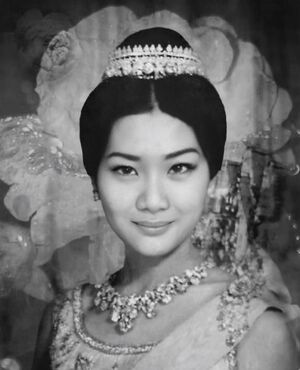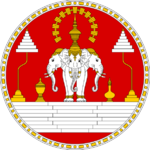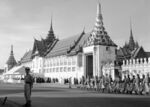Anula Ravin of Ankat
| Anulā Ravin | |||||
|---|---|---|---|---|---|
 | |||||
| Queen of Ankat (more...) | |||||
| Reign | 16 December 1950 – 7 March 1968 (17 years, 2 months, 20 days) | ||||
| Coronation | 20 December 1950 | ||||
| Predecessor | Ravin Ajantha | ||||
| Successor | Ankati Civil War | ||||
| Prime Ministers | |||||
| Born | 5 July 1926 Royal Palace, Nilagne Naegima, Ankat | ||||
| Died | 7 March 1968 (age 41) Royal Palace, Nilagne Naegima, Ankat | ||||
| Consort | XXXX (m. 1945) | ||||
| Issue |
| ||||
| |||||
| House | House of Vijalanya | ||||
| Father | Ravin Ajantha | ||||
| Mother | Queen Consort Aryen | ||||
| Religion | Sudu Mārgaya | ||||
Anulā (Terasi:විජාලන්යා ගේ නිවසේ රවීන්ගේ සහ ආර්න්ගේ දියණිය අනුලා, tr; Vijālanyā gē nivasē Ravīngē saha ārngē diyaṇiya Anulā; 5 July 1926 - 7 March 1968) was the last queen of the Royal Kingdom of Ankat and the fifth queen of the country. She ruled from 1950 after her father's death until 1968 when during the Ankati Revolution she was killed. Her reign has been subject to many historical debates as documents from her time as queen have largely been destroyed during the sack of the Royal palace shortly after her death. The current government of the Socialist Republic of Ankat has stated and procured documents stating that Queen Anulā instigated multiple instances of human rights abuses, with the 1967 Tan Mar Massacre, a widely documented incident between royal forces and protestors in Tan Mar in the months leading up to the revolution being the most widely documented. Despite evidence shown by the socialist government, many commentators insist that the Tan Mar massacre was conducted by overzealous military commanders operating without orders and that other accusations by the socialist government are unfounded, with some pieces of evidence being exposed as fraudulent.
In her life she was often referred to as a modernising influence for the country, overseeing overhauls within the nations cities that helped turn Nilagne Naegima, the nations capital, into a flourishing metropolis for the region by the turn of the century and her influences can still be felt today in the modern artwork seen throughout the country. She followed lessons of her father in cultivating relations with Mutul, Pulau Keramat and select nations both in the region and in Belisaria, where she often vacationed and had purchased a summer house in XXXX. She was the only child of her father, Ravin Ajantha, and as the crown princess had ownership of the Saśrīka Kanda, or Flourishing Hill. A large estate in the Simhaya mountains.
Following the revolution her legacy has been subject to debate and differences of opinion steeping into the viewers bias toward the socialist movement or to the monarchist cause. For the socialists she is viewed as a tyrannical leader who, they say, directly ordered masses of executions and ordered her troops to conduct the 1967 Tan Mar Massacre and personally ordered the execution of Vimukthi Ratnam, her former Prime Minister and leader of the Torists. To the monarchists she is seen as a queen who, despite doing great things for her people was ultimately a victim of overzealous commanders who covered up their mistakes until, ultimately, the Torists led the revolution against her. Anulā and her eldest son, Prince Nimal, were killed when members of the Kaha Mal sacked the Royal Palace during the First Battle of Nilagne Naegima at the start of the Ankati Civil War. Senior members of her Royal Guard fled the palace with her remaining children, although with the palace being burnt down and a socialist victory in the civil war, the monarchy effectively ended with Anulā's death.
Early Life and education
Anulā was born on the 5th of July 1926 to King Ravin Ajantha of the House of Vijalanya and to mother Ayren of the House of Vinjan at the Royal Palace as their only child. In Terasi royalty naming customs, she was born with her given name, Anulā, and her family name Vijālanyā gē nivasē Ravīngē saha ārngē diyaṇiya Anulā which translates to "Anulā, daughter of Ravin and Aryen of the house of Vijalanya". As well as this, formally she is also known as Anulā Ravin, taking on the Terasi royal naming in which reigning monarchs take their predecessors name. Her position as the first child and the existence of Absolute primogeniture within the country granted her the title of Crown Princess on birth until her ascension in 1950. Her early years were spent at Saśrīka Kanda in the Simhaya mountains with her mother, the Sudu Mārgaya monks, her brother Diyon born a year later and her growing personal court. She made her debut to the royal court in Nilagne Naegima at the age of 13 in 1939 at the annual celebrations of the ascension of her father. During this she was being subject to home schooling by personal tutors.
Upon reaching age 18 in 1944 she conducted her first royal visit to Mutul before spending some time within Latium and other Belisarian courts in a bid to continue fostering relations.
Queen of Ankat
On the death of her father, King Ravin, on 16 December 1950 Anulā became the Queen of Ankat, and as traditional with Terasi monarchs took on the name of Anulā Ravin, a custom that holds monarchs to take their predecessors name as their second name. Four days later, on 20 December, Anulā was coronated at the Royal Palace in a ceremony that had been prepared as the King's health began declining in June. The start of Anulā's 17-year reign was celebrated across the country and between 21 December 1950 and 4 April 1951 Anulā toured the country and paid homages at the numerous Sudu Mārgaya temples, including the Bhagyavatun Vahanse.
--
In the aftermath of the 1967 Tan Mar Massacre, protests had erupted around the country as pro-democratic newspapers pinned the blame directly onto Anulā, indicating that she had ordered her personal guard to conduct the massacre. With riots around the country growing in intensity and having been slowly growing to view the monarchy as outdated, the elected government under the Queen, known as the Tor, sent the Prime Minister Vimukthi Ratnam to petition the Queen to step down and allow the democratic Torists to take over. Her response was the immediate arrest of Ratnam and the order of his execution.
senior Torist Daya Dalusinghe met with his brother, General Nalin Dalusinghe who commanded a division-sized force stationed outside of the nations capital of Nilagne Naegima and after tense talks with him and his officers they agreed to raise their flag in revolt and at dawn of March 4th marched 45,000 troops into Nilagne Naegima meeting fellow Torists Bertram Silva and Ananda Muttukumaru who had convinced the rest of the Tor to meet them at the Royal Palace to demand the queens abdication in favor of her 9-year old son Prince Nimal, a move critics believed would leave the Torists in full control of the country. They were meant to meet with Ranjan Peries, a member of the royal court who would guarantee them access to the Queen upon their arrival.
Unknown to the conspirators, Ranjan had met with the queen during the night and had informed her of the Torists plot. Upon their arrival at the Royal Palace just before mid-day, they were met with the hanged body of Vimukthi Ratnam and surrendering members of the Royal Guard who told them the Queen had fled with her family toward neighbouring Gam Ivura by train. Her transport to Gam Ivura went without issue, but the city was in the process of suppressing revolts in some boroughs and the Queen and her family were escorted to the city's palace.
Queen Anulā and her eldest son, Prince Nimal, were both killed during the Sack of the Royal Palace at the outset of the Ankati Civil War. Her death signalled the end of the sitting monarchy in the country, and at the end of the civil war the government was dissolved in favour of a socialist government under the Socialist Republic. Her children fled to friendly nations and have, since her death, been at high risk of assassination such as Prince Juyanti in 1999, who was shot dead in the street by two women who had travelled directly to his location from Nilagne Naegima and had false identities. The two women, sentenced to life in prison in XXXX, are believed by many to be members of the Ankat National Party's elite paramilitary unit, which are often deployed to conduct operations on behalf of the party itself.
Historians believe that a lot of the internal discourse that ultimately led to the downfall of the monarchy can find it's origin within both Queen Anulā's and her father's pro-Belisarian approach. One after effect of this can be seen in the modern Socialist government's harsh rhetoric and stance toward what they believe to be "Belisarian imperialism" within the Ozeros.
Legacy
Titles, styles, honors and arms
| Styles of The Queen | |
|---|---|
 | |
| Reference style | Her Majesty |
| Spoken style | Your Majesty |
Styles of address
- 5 July 1926 - 16 December 1950: Her Royal Highness the Crown Princess
- 16 December 1950 – 7 March 1968: Her Majesty the Queen
Decorations
Awards
Issue
| Name | Birth | Death | Spouses |
|---|---|---|---|
| By XXXX (b. XXXX): | |||
| Nimal | 14 February 1949 | 7 March 1968 (age 18) | N/A |
| Juyanti | 18 October 1952 | 23 April 1999 (age 46) | |
| Sihad | 11 March 1955 | ||
| Jihan | 6 August 1963 | ||
See also
Anula Ravin of Ankat Born: 5 July 1926 Died: 7 March 1968
| ||
| Royal titles | ||
|---|---|---|
| Preceded by Ravin Ajantha |
Queen of Ankat 1950-1968 |
Monarchy abolished |


